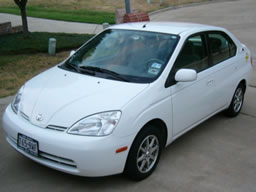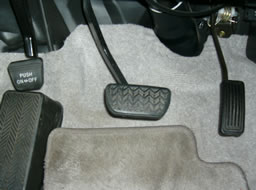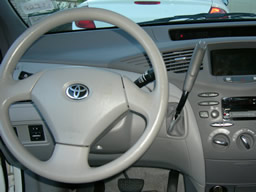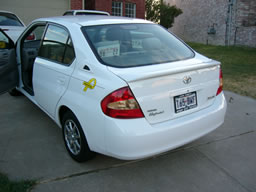 I have a car now: it’s a Toyota Prius, year 2002 and I love it. I never bought it to save me money, but rather to make a statement about the fact that we all need to start getting off this black liquid death stuff and onto something cleaner. It makes that statement by being quite small in comparison to the other cars on the road, and by having quite distinctive lines.
I have a car now: it’s a Toyota Prius, year 2002 and I love it. I never bought it to save me money, but rather to make a statement about the fact that we all need to start getting off this black liquid death stuff and onto something cleaner. It makes that statement by being quite small in comparison to the other cars on the road, and by having quite distinctive lines.
Then there’s the way it sounds. When driving down side-streets at about 10-20 mph (16-40 km/h) all you can hear is the gentle whir of the powerful electric motor. This is what I call “golf cart” mode. In this mode, the car is running completely off battery. You can run the battery down pretty quickly like this but it’s nice to see the bar shoot to “100 mpg” for a few moments. The car currently makes one other statement: the yellow sticker on the back says “support our troops”. I don’t have the heart to take it off just yet, the Texans are so proud of their military. I will replace it with more liberal sentiments soon.
 Apart from the fact that it’s a hybrid, there are two rather interesting anomalies about this car. For one, the “hand break” is actually a foot break. You can see it there on the left of this image, You use your foot to push the break in and out (in is “engaged”). The other strange thing is the gear stick. It’s up by the steering wheel next to the windscreen wipers. These combine to make driving it a sometimes embarrassingly complex affair.
Apart from the fact that it’s a hybrid, there are two rather interesting anomalies about this car. For one, the “hand break” is actually a foot break. You can see it there on the left of this image, You use your foot to push the break in and out (in is “engaged”). The other strange thing is the gear stick. It’s up by the steering wheel next to the windscreen wipers. These combine to make driving it a sometimes embarrassingly complex affair.
A word about mileage: when I first got the car I was determined to keep up with the big boys on the interstate. I found this was quite easy, with a combined petrol & electric power of over 100 hp, this car is no slouch, and being light it can take off at the lights faster than any of these enormous diesel tankers the people over here tend to drive. Then I realised I was getting around 43 miles per gallon on the interstate and I didn’t like it. So I have been working on my “pulse and glide”.
 The basic premise of the Prius is that a lot of energy is wasted in starting and stopping your car. You turn fossil fuels into kinetic energy in order to start off, this takes power and because the conversion is necessarily lossy, you lose energy in the form of heat.
The basic premise of the Prius is that a lot of energy is wasted in starting and stopping your car. You turn fossil fuels into kinetic energy in order to start off, this takes power and because the conversion is necessarily lossy, you lose energy in the form of heat.
When it comes time to slow down, you will need to use the breaks, those take away the kinetic energy put into the car and turn it directly into heat through friction. This ia a great waste. Then, while you’re waiting at the lights, the engine ticks over because no one is willing to turn their car off at the lights. Finally, when “freewheeling” on the freeway, the car is coasting along without requiring much input from the engine, in fact, you may even be freewheeling down hill, but because the engine is engaged, it has to keep on going, essentially adding nothing to the equation but noise.
 Aah, that reminds me: the car shows you where the power that drives the wheels is coming from. It’s a really nifty little touch-screen. I can get information about my mileage and whether the engine is doing any work.
Aah, that reminds me: the car shows you where the power that drives the wheels is coming from. It’s a really nifty little touch-screen. I can get information about my mileage and whether the engine is doing any work.
What the Prius (and other cars like it) does is address these issues. When taking off from a stop, the electric engine with continuously variable transmission pulls away much more efficiently, allowing the petrol engine to kick in to add extra torque only when needed. When slowing down and stopping it uses “regenerative breaking” which uses the electric engine like an alternator to both slow down the car and recharge the batteries. When at a stop, the motors cut out and it waits patiently to pull off, ready at a moment’s notice. When coasting, it turns off both engines and can even charge the batteries while running down hill.
 So, really, it’s not an alternative energy car, it’s still a petrol car, however is makes much more efficient use of that petrol and that is the key. Back to the pulse and glide: by watching the little meter, I have become more conscious of where the petrol is going. After reading a bit, it became apparent that the best thing to do is to do my best to try drain the battery as much as I can. On the freeway, this means pressing the accelerator down and getting up to a high speed (sometimes 70, depending on the road) and then, when I get the momentum going, easing off a bit and allowing the petrol engine to cut off, leaving only the electric engine on.
So, really, it’s not an alternative energy car, it’s still a petrol car, however is makes much more efficient use of that petrol and that is the key. Back to the pulse and glide: by watching the little meter, I have become more conscious of where the petrol is going. After reading a bit, it became apparent that the best thing to do is to do my best to try drain the battery as much as I can. On the freeway, this means pressing the accelerator down and getting up to a high speed (sometimes 70, depending on the road) and then, when I get the momentum going, easing off a bit and allowing the petrol engine to cut off, leaving only the electric engine on.
You see, the petrol engine is very efficient for bursts of speed, but not for cruising. For cruising, I need to trick the batteries into doing the work. This method works really great in the city and in hilly country. Using this technique, my trip home was a whopping 50mpg, which is about what you would expect in the city, not on the freeway. I am happy.
 There are other rather cool features. It sports aluminium wheel rims (or something like that, they look fancy) and those really nifty narrow Michelin tyres (new). The Tyres are narrow so as to provide better mileage. It also means that if I accelerate from a stop too quickly, I get a rather impressive wheel spin (no, Mom, I don’t do it on purpose, honest). It also has a 6CD changer (which can hold about 90% of my entire CD collection) and “keyless entry” remote door lock / unlock (a wok-wok button dangling on the keys).
There are other rather cool features. It sports aluminium wheel rims (or something like that, they look fancy) and those really nifty narrow Michelin tyres (new). The Tyres are narrow so as to provide better mileage. It also means that if I accelerate from a stop too quickly, I get a rather impressive wheel spin (no, Mom, I don’t do it on purpose, honest). It also has a 6CD changer (which can hold about 90% of my entire CD collection) and “keyless entry” remote door lock / unlock (a wok-wok button dangling on the keys).
Those are my keys in the image there by the way. They comprise: my car key, door remote, house key, key to the confidential documents in my office drawer and the 2-factor authentication token for the Beca network.